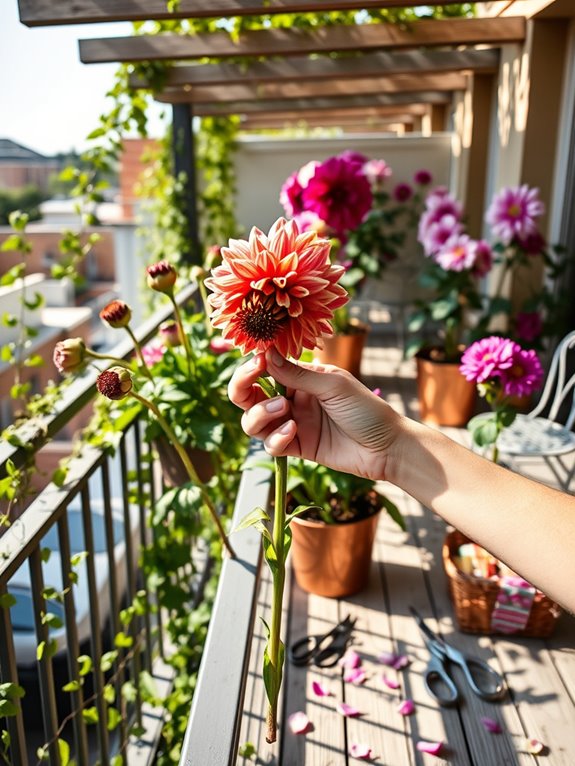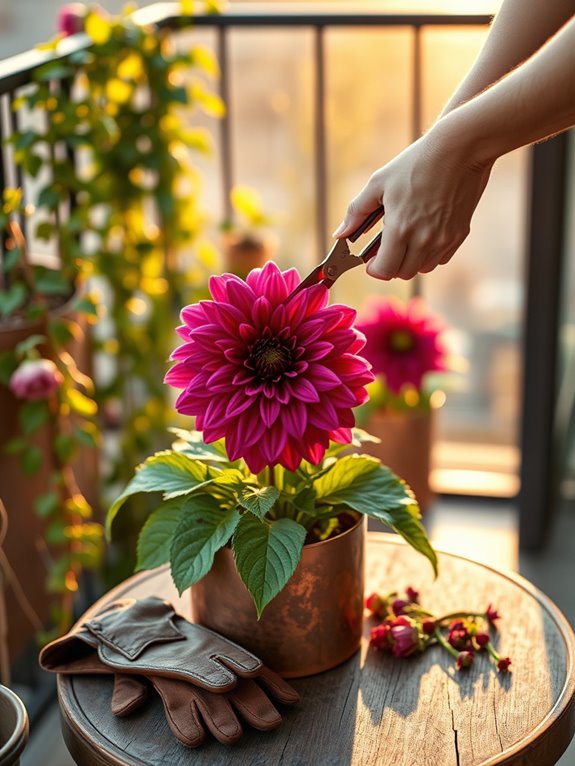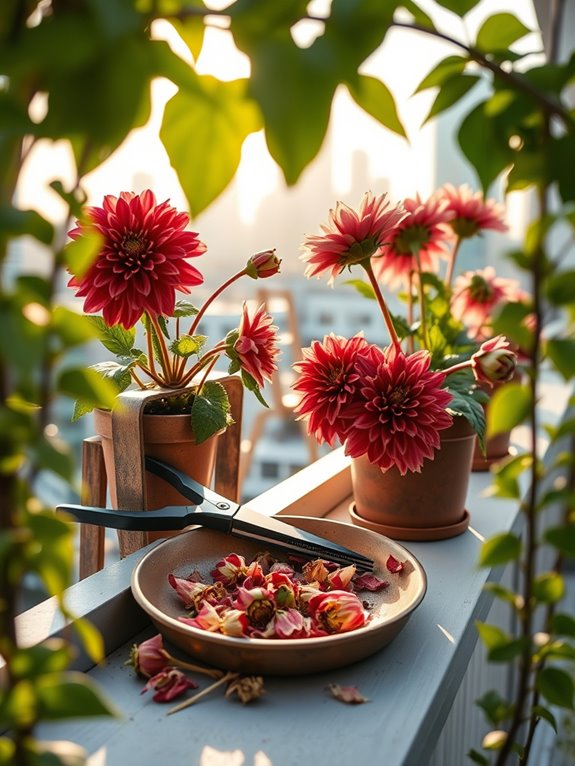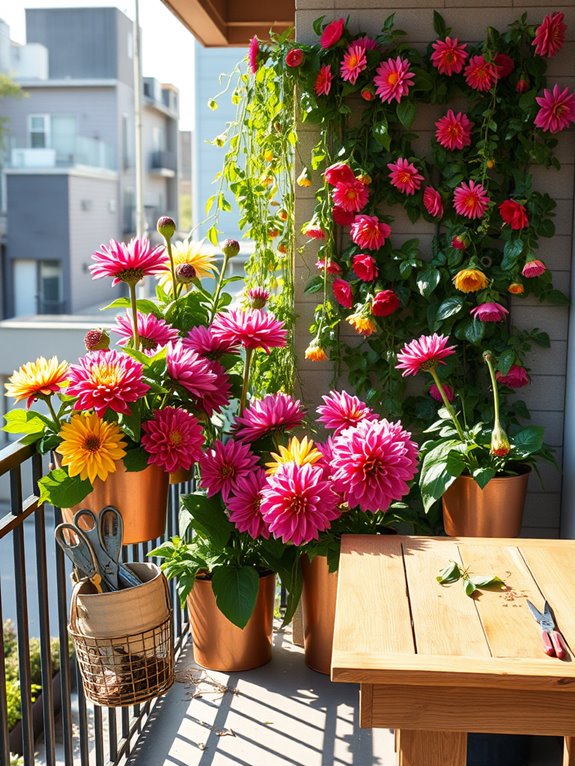Should Dahlias Be Deadheaded? How It Boosts Blooming
Like a gardener pruning their prize roses, you’ll discover that deadheading your dahlias is an crucial skill for achieving those jaw-dropping blooms. You’re probably wondering why removing spent flowers makes such a difference in your garden’s vigor and visual appeal. From the science behind this simple practice to the proper techniques that’ll transform your dahlia display, there’s much more to deadheading than meets the eye. Let’s explore how this time-tested technique can maximize your dahlia’s flowering potential.
Contents
- 1 Understanding the Science Behind Deadheading Dahlias
- 2 Signs Your Dahlia Blooms Need Deadheading
- 3 Step-by-Step Guide to Proper Deadheading Techniques
- 4 Best Tools and Equipment for Deadheading
- 5 Common Mistakes to Avoid When Deadheading Dahlias
- 6 Timing and Frequency of Deadheading Throughout the Season
- 7 Additional Benefits of Regular Deadhead Maintenance
- 8 Frequently Asked Questions
Understanding the Science Behind Deadheading Dahlias

When you understand the science of deadheading dahlias, you’ll reveal the secret to extending their blooming season and maximizing their flower production. Your dahlia naturally directs its energy toward seed production once a flower begins to fade, but by removing spent blooms, you’re actually triggering the plant’s survival response. This process redirects energy from seed development back into creating new flowers.
The plant’s hormones, particularly auxins and cytokinins, play a significant role in this process. As you remove faded flowers, these hormones shift their focus from maintaining dying blooms to stimulating new bud formation. The plant’s resources – water, nutrients, and sugars – now flow toward fresh growth points instead of supporting spent flowers, resulting in more abundant, colorful blooms throughout the season.
Signs Your Dahlia Blooms Need Deadheading
Spotting the right moment to deadhead your dahlias makes all the difference in maintaining their vibrant display. You’ll know it’s time to trim when you notice specific changes in your dahlia blooms that signal they’re past their prime.
Look for these clear signs that indicate your dahlia needs deadheading:
- Petals appear wilted, brown, or drooping while losing their original bright color
- Center of the flower looks dry and begins to turn dark or mushy
- Bloom head feels loose and papery when gently touched
- Petals start falling off naturally when the flower head moves in the breeze
- Seed pod begins forming at the flower’s base, appearing as a small green swelling
Watch for these indicators daily during the blooming season, and you’ll develop an instinct for perfect deadheading timing.
Step-by-Step Guide to Proper Deadheading Techniques

Proper deadheading of dahlias requires just three simple tools: clean, sharp pruning shears, gardening gloves, and a collection bucket for the spent blooms. Find the stem you’ll cut and trace it down to the first set of healthy leaves, where you’ll make your cut at a 45-degree angle.
| Step | Action | Location |
|---|---|---|
| 1 | Identify | Find wilted bloom |
| 2 | Trace | Follow stem to leaves |
| 3 | Cut | Above leaf junction |
Hold the stem firmly with your non-dominant hand while making a clean cut with your shears. You’ll want to remove both spent blooms and any buds that look damaged or misshapen. After cutting, place the removed material in your collection bucket to keep your garden tidy. Remember to clean your tools between cuts to prevent spreading plant diseases.
Best Tools and Equipment for Deadheading
Successful deadheading starts with having the right tools at your disposal. When you’re equipped with proper pruning implements, you’ll get cleaner cuts and prevent damage to your dahlia plants.
- Sharp bypass pruners with spring-loaded handles for quick, precise cuts
- Clean, rust-resistant garden scissors with pointed tips for reaching tight spots
- Ergonomic pruning snips with comfort grips for extended deadheading sessions
- Small bucket or collection basket to gather spent blooms
- Rubbing alcohol or diluted bleach solution for sanitizing tools
Keep your tools clean and sharp to prevent spreading diseases between plants. You’ll want to wipe down your cutting implements between uses with disinfectant, and store them in a dry place to prevent rust. Good tools make deadheading more efficient and enjoyable, helping you maintain healthy, productive dahlia plants throughout the growing season.
Common Mistakes to Avoid When Deadheading Dahlias

While deadheading dahlias might seem straightforward, many gardeners make common mistakes that can harm their plants or reduce blooming potential. Don’t cut too close to the next flower bud, as you might accidentally damage developing blooms. It’s also essential not to leave long stems behind, which can become entry points for pests and diseases.
Many gardeners mistakenly remove only the spent flower head while leaving the stem intact, but you’ll want to trace the stem down to the first set of healthy leaves before making your cut. Another common error is using dull or dirty tools, which can crush stems and spread disease. You shouldn’t deadhead when the foliage is wet, as this increases the risk of fungal problems. Remember to dispose of the removed blooms properly, rather than letting them accumulate around the plant’s base.
Timing and Frequency of Deadheading Throughout the Season
Regular deadheading keeps dahlias blooming vigorously from mid-summer through the first frost. To maintain your dahlia’s health and continuous blooming, develop a consistent deadheading schedule that works with your garden routine.
- Check your dahlias every 2-3 days during peak blooming season for spent flowers
- Remove blooms when petals start drooping, turning brown, or falling off
- Deadhead more frequently during hot, dry spells when flowers fade quicker
- Increase deadheading sessions to twice weekly during August and September’s peak bloom
- Reduce deadheading in late fall as temperatures drop and plants prepare for dormancy
When you maintain this schedule, you’ll enjoy waves of fresh, colorful blooms throughout the growing season. Cut stems at a 45-degree angle just above the nearest set of leaves to encourage strong new growth and prevent stem damage.
Additional Benefits of Regular Deadhead Maintenance

Beyond promoting continuous blooming, diligent deadheading of your dahlias brings several remarkable benefits to your garden’s overall health and appearance. You’ll notice these perks as you maintain your dahlia patch throughout the growing season.
| Benefit | Impact | Result |
|---|---|---|
| Disease Prevention | Removes decaying matter | Reduces fungal growth |
| Plant Energy | Redirects nutrients | Stronger stems and roots |
| Garden Aesthetics | Maintains neat appearance | Professional-looking display |
Regular deadheading helps you spot pest problems early, giving you time to address issues before they spread. You’ll also find that cleaned-up dahlia plants create better air circulation between stems, which reduces the risk of powdery mildew. As an added bonus, you’ll collect spent blooms that you can toss into your compost bin, creating nutrient-rich soil for next season’s garden.
Frequently Asked Questions
Can Dahlias Survive Winter if I Don’t Deadhead Them?
Your dahlias’ winter survival doesn’t depend on deadheading. Instead, you’ll need to dig up the tubers after the first frost, store them in a cool, dry place, and replant them in spring.
Will Deadheading Affect the Color of Next Year’s Blooms?
No, deadheading won’t change your dahlia’s bloom colors next year. The flower colors are determined by genetics, not pruning practices. You’ll get the same beautiful shades you originally planted year after year.
Can I Compost the Deadheaded Dahlia Flowers?
Yes, you can add your deadheaded dahlia blooms to your compost pile. They’ll break down nicely and contribute nutrients to your compost. Just make sure they’re disease-free before adding them to the mix.
Do All Dahlia Varieties Require the Same Deadheading Schedule?
While your ‘Café au Lait’ dahlias might need weekly deadheading, you’ll find most dahlia varieties follow similar schedules. You’ll want to remove spent blooms every 7-10 days during peak flowering season.
Should I Deadhead Dahlias if I Want to Collect Seeds?
No, don’t deadhead if you want seeds. You’ll need to let some blooms mature and dry completely on the plant. When the flower head turns brown and crispy, that’s when you can collect seeds.
